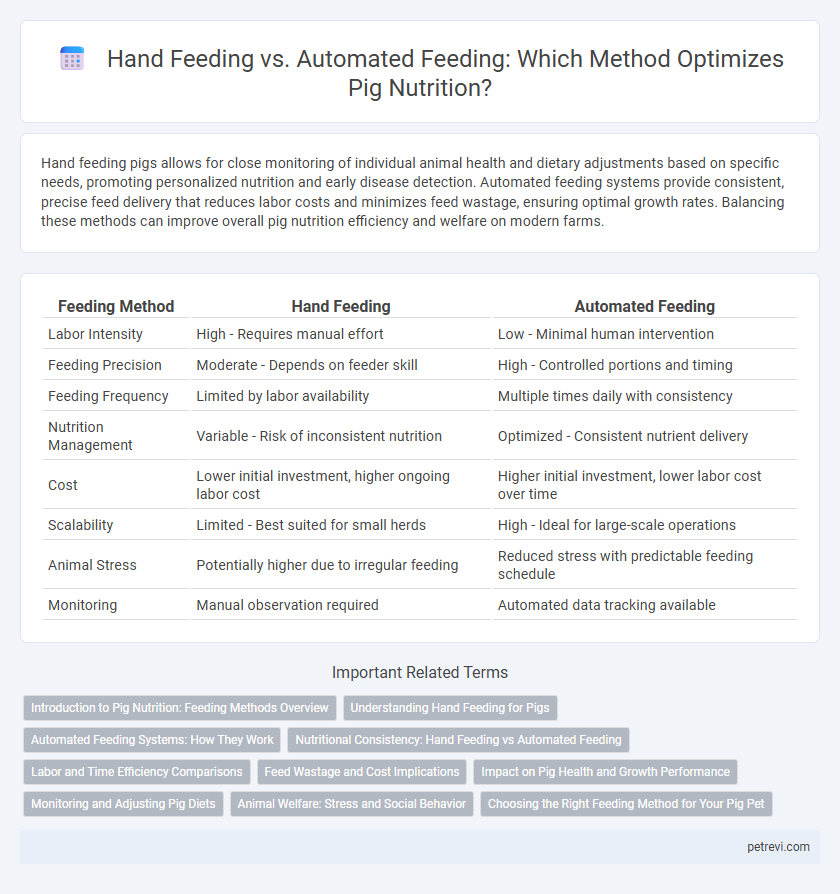Hand feeding pigs allows for close monitoring of individual animal health and dietary adjustments based on specific needs, promoting personalized nutrition and early disease detection. Automated feeding systems provide consistent, precise feed delivery that reduces labor costs and minimizes feed wastage, ensuring optimal growth rates. Balancing these methods can improve overall pig nutrition efficiency and welfare on modern farms.
Table of Comparison
| Feeding Method | Hand Feeding | Automated Feeding |
|---|---|---|
| Labor Intensity | High - Requires manual effort | Low - Minimal human intervention |
| Feeding Precision | Moderate - Depends on feeder skill | High - Controlled portions and timing |
| Feeding Frequency | Limited by labor availability | Multiple times daily with consistency |
| Nutrition Management | Variable - Risk of inconsistent nutrition | Optimized - Consistent nutrient delivery |
| Cost | Lower initial investment, higher ongoing labor cost | Higher initial investment, lower labor cost over time |
| Scalability | Limited - Best suited for small herds | High - Ideal for large-scale operations |
| Animal Stress | Potentially higher due to irregular feeding | Reduced stress with predictable feeding schedule |
| Monitoring | Manual observation required | Automated data tracking available |
Introduction to Pig Nutrition: Feeding Methods Overview
Hand feeding in pig nutrition allows precise control over individual pig diets and immediate adjustment based on behavior and health indicators, promoting optimal growth and welfare. Automated feeding systems improve efficiency by delivering consistent, measured portions tailored to pigs' age and weight, reducing labor costs and minimizing feed waste. Both methods impact nutrient intake and growth performance, with the choice dependent on farm size, management goals, and technological investment.
Understanding Hand Feeding for Pigs
Hand feeding pigs allows for precise control over individual nutrition needs, ensuring each animal receives the appropriate feed quantity and quality to support optimal growth and health. This method enables early detection of health issues through close observation, allowing timely adjustments in diet and care. While more labor-intensive than automated systems, hand feeding facilitates personalized management that can enhance overall herd performance and welfare.
Automated Feeding Systems: How They Work
Automated feeding systems for pigs utilize programmable controls and sensors to deliver precise amounts of feed at scheduled intervals, optimizing nutrition and reducing waste. These systems monitor individual pig intake and adjust feed composition based on growth stage and health metrics, improving overall herd performance. Integration with data management software enables real-time tracking and analysis, ensuring efficient feeding operations and enhanced animal welfare.
Nutritional Consistency: Hand Feeding vs Automated Feeding
Automated feeding systems provide greater nutritional consistency for pigs by delivering precise amounts of feed at scheduled intervals, ensuring uniform nutrient intake which supports optimal growth and health. Hand feeding may result in variable feed quantities and timing, potentially causing uneven nutrient distribution and impacting pig performance. Consistent nutrient delivery through automation reduces feed wastage and enhances feed conversion efficiency compared to manual methods.
Labor and Time Efficiency Comparisons
Hand feeding pigs demands significant labor and time, limiting efficiency on larger farms and increasing operational costs. Automated feeding systems optimize labor by reducing manual intervention, allowing precise feed delivery and saving valuable time. These systems improve overall productivity by streamlining the feeding process and enabling better resource allocation in pig nutrition management.
Feed Wastage and Cost Implications
Hand feeding pigs often results in higher feed wastage due to inconsistent portion control and overfeeding, which directly increases operational costs. Automated feeding systems deliver precise feed quantities based on pig growth stages, reducing wastage and optimizing feed efficiency. Although the initial investment in automated feeders is substantial, the long-term cost savings from decreased feed loss and improved feed conversion ratios make them economically advantageous.
Impact on Pig Health and Growth Performance
Hand feeding allows precise control over pig nutrition, enabling tailored diets that can improve health and growth performance through close monitoring of feed intake and immediate adjustments. Automated feeding systems ensure consistent feed delivery and reduce labor costs, promoting uniform growth rates and minimizing stress associated with feeding competition. However, automated feeding may limit individual attention to pigs with specific dietary needs, potentially impacting health outcomes in certain cases.
Monitoring and Adjusting Pig Diets
Hand feeding allows precise control over individual pig diets, enabling real-time monitoring of consumption and immediate adjustments based on pig health and behavior. Automated feeding systems utilize sensors and data analytics to track feed intake accurately and adapt nutrient delivery according to growth stages and performance metrics. Combining technology with observational skills ensures optimal nutrition management, improving feed efficiency and pig growth outcomes.
Animal Welfare: Stress and Social Behavior
Hand feeding allows for individualized attention, reducing stress by closely monitoring pigs' health and social interactions, but it can cause disruption in group dynamics due to human presence. Automated feeding systems provide consistent feed delivery that minimizes competition and aggression among pigs, promoting stable social behavior and lowering stress levels. Both methods impact animal welfare, with automated feeding generally enhancing group cohesion and reducing stress-related behaviors in pigs.
Choosing the Right Feeding Method for Your Pig Pet
Hand feeding pigs allows for precise control over portion sizes and individualized nutrition, ensuring each pig's dietary needs are met accurately. Automated feeding systems provide consistent feeding schedules and reduce labor, promoting steady growth and minimizing human error. Selecting the optimal feeding method depends on your pig's specific health requirements, the scale of care, and available resources to maintain nutritional balance.
Hand feeding vs Automated feeding for Pig nutrition Infographic

 petrevi.com
petrevi.com